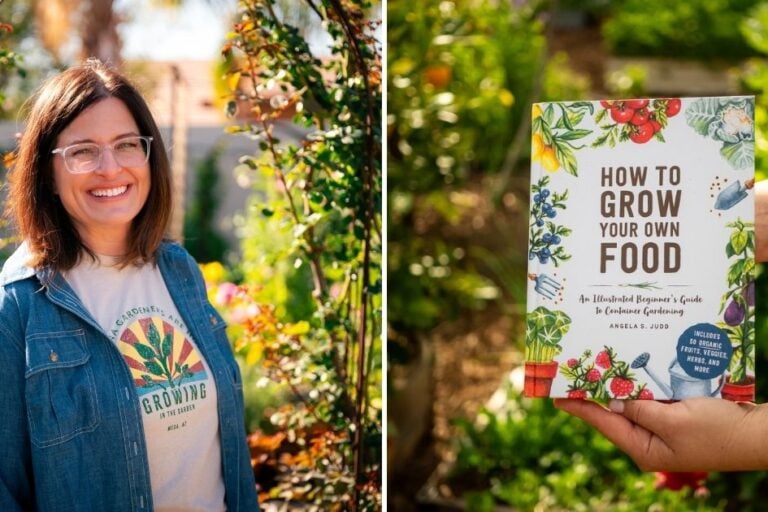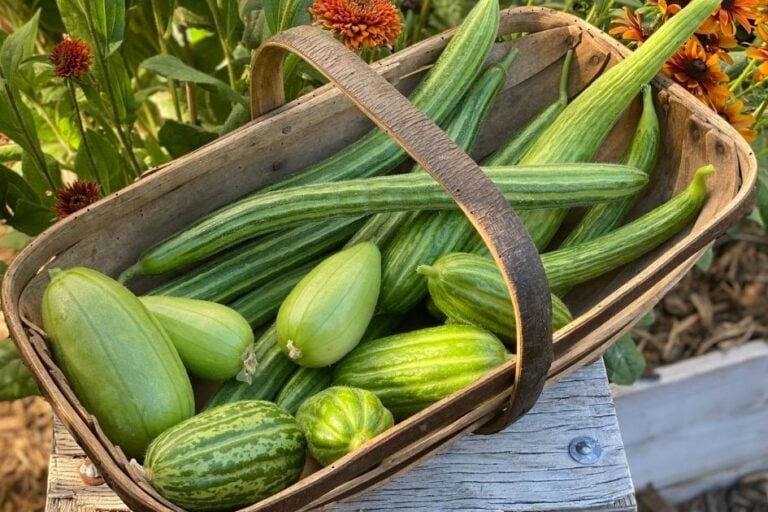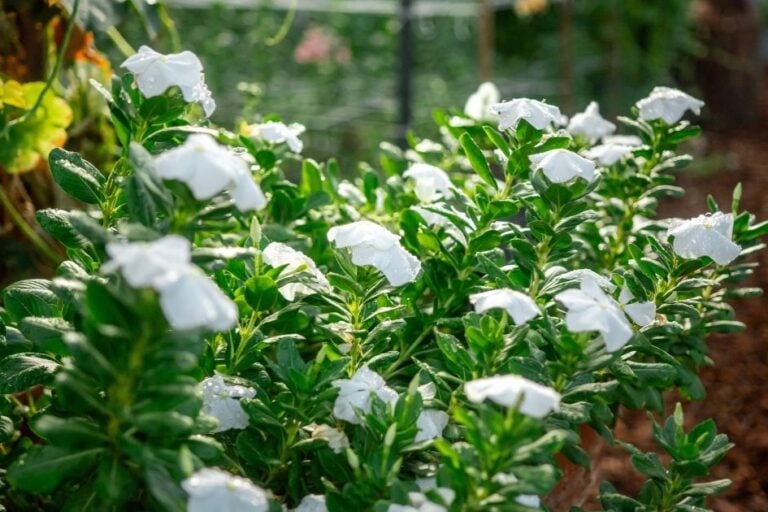Inspiring Gardener: Vera Greutink, author of Edible Paradise
“My hope is that wherever you find yourself on your gardening journey, whether you are a complete beginner or a seasoned veteran, this book will provide you with inspiration and practical steps that will not only make your gardening life easier and more enjoyable but will also improve the soil you are tending and contribute to the diversity in your area.”
– Vera Greutink

Inspiring Gardener: Vera Greutink, author of “Edible Paradise”
Vera Greutink is a permaculture gardener, teacher and designer based in the Netherlands. She’s been gardening for over 30 years. A regular contributor to Dutch, Belgian, and English magazines, she recently published “Edible Paradise – How to grow herbs, flowers and veggies in any space“.
I first connected with Vera Greutink on her popular Instagram page “GrownToCook“. She generously shares information and teaches others through her posts and thoughtful answers to questions. Vera’s authenticity and encouraging manner inspire other gardeners in the online community on her YouTube channel as well.
Vera was kind enough to let me interview her for this post, and I’m happy to share her thoughts about gardening and her new book with you here on the blog.
Disclaimer: this post contains affiliate links. See my disclosure policy for more information.

What inspired you to begin gardening?
“When I was twelve, my parents started a small vegetable garden – from the beginning, I was fascinated and loved to help there. I even created a tiny plot of my own, which was a complete disaster. It was under a large acacia tree which cast a lot of shade and sucked up moisture and nutrients. It was a valuable lesson in what conditions annual vegetables need to thrive!”

What is permaculture and how do you incorporate it into your garden?
“In the broadest sense, permaculture is a design framework inspired by natural ecosystems. I used many of the permaculture design principles when I was setting up our plot in order to make the best possible use of the space. For example, placing the individual elements such as raised beds, pond or compost heap in the best location relative to one another helps to create beneficial relationships and potentially saves a lot of work later.
Kitchen gardens with mostly annual vegetables are of course quite different from the natural ecosystem, but even here there are lessons we can adopt from nature. For me, the most important techniques are no-dig and the use of mulch. Together they are natural ways to gradually build a healthy, well-structured soil teeming with life.”
“I’m always trying to increase diversity by planting vegetables in polycultures instead of monocultures. Not only does it help to prevent disease and pest damage, but these polycultures can also be very pretty too.”

“In the broadest sense, permaculture is a design framework inspired by natural ecosystems.”
The advice Vera gives to someone who wants to incorporate permaculture principles into their existing garden
“Make the health of your soil a priority: if you dig, consider trying not to – it will save you a lot of work and will be beneficial for soil life. Mulching too saves an enormous amount of work and resources. There is less watering and less weeding. And lastly: try your hand at planting a polyculture.
There are many examples in my book, but you can also have fun designing your own, for example around a specific cuisine. This year I’m growing an Italian polyculture with cannellini beans, Roma tomatoes, eggplant, flat leaf parsley, oregano and, of course, lots of basil.”
“Make the health of your soil a priority: if you dig, consider trying not to – it will save you a lot of work and will be beneficial for soil life.”

Vera’s favorite things to grow
“If I could only grow one thing it would be lettuce because it’s easy, grows fast and tastes so much sweeter fresh from the garden. Generally, I like to grow vegetables that are better when eaten absolutely fresh – sugar snap peas, sweet corn, and asparagus.
Like most gardeners I love tomatoes but in our climate, they are very susceptible to blight so I am always on the lookout for resistant varieties. This year I’m trialing 5 supposedly resistant varieties that I have not grown before – fingers crossed some of them will be keepers!”

Inspiring Gardener: Vera Greutink’s harvests through the seasons






How the idea for the book “Edible Paradise” came about
“I started writing about edible gardening for various magazines about ten years ago. Writing a book was the natural next step but I only wanted to do it when I had enough to say that I felt hadn’t been said and done before. I wanted to create a book that would empower beginning gardeners and inspire experienced gardeners to try something new.
“Edible Paradise” covers all the basics of growing and explains the different permaculture techniques in detail. Since permaculture gardening means teaming up with nature instead of fighting against it, it makes life easier for the gardener. But most importantly I think, the book contains lots of real-life examples of gardens of various sizes, starting with large containers. The examples are broken down to the concrete varieties that I used so that even if it’s your first year growing, you can easily follow them. Then, as you gain experience, I hope you’ll be inspired to build on that.”
“A reader once said to me: ‘You take the stress out of gardening,’ and that’s exactly what I hoped to accomplish with my book – demystify gardening and permaculture techniques and make it all approachable and fun.”

“Edible Paradise is a goldmine of knowledge and inspiration for any gardener, with Vera’s voice clearly guiding you through the creativity of growing your own delicious food.”
– Huw Richards, YouTuber, Author and organic gardener
What is “Smart Growing”?
“This chapter is all about getting the most out of the space you have available: successional planting and intercropping can virtually double the size of your garden. Learn more about succession planting in this guide.
For example, I like to interplant my sweet corn with chard: the corn will protect the chard from too much sun during the warmest months, preventing it from bolting prematurely, while the chard will keep the soil covered and will prevent weed growth and excessive evaporation.
Another trick is to use various harvesting techniques to prolong the harvest period and increase your yield. Some vegetables will regrow after harvesting and some leafy plants can be cut repeatedly. In other cases, you can eat more parts of the plants than those for which they are normally grown: the flowers of kale, leaves of winter squash, the stem of the lettuce that has bolted.”

What are some tips for gardening year round in a cooler climate?
“Using row covers is an easy way to extend your season – under their protection I can start my seeds earlier or keep plants going longer in fall, but they also protect crops from pests. Before we built our greenhouse two years ago, we had a small cold frame in which we grew a variety of hardy greens for winter harvests: winter purslane, spinach, mustard greens, chervil, parsley.”

“I like to be able to pick a salad from my garden even in the middle of the winter and it’s amazing what a difference even such a simple structure as a cold frame makes.”

Will you share a favorite recipe from the book?
“There are recipes sprinkled throughout my book, using the produce that I write about. One of my favorites which is perfect for summer is the stuffed zucchini with quinoa, sweet corn, and cherry tomatoes. Pretty much all of the ingredients, including the quinoa, can be grown in one of the polycultures.”

Stuffed courgettes
2 medium-sized courgettes (zucchini)
100g (2/3 cup) quinoa
1 tbsp olive oil
1 small onion, minced
1 clove of garlic, minced
Kernels from 1 ear of sweet corn
350g (12oz) cherry tomatoes, halved
A handful of basil leaves roughly chopped
50g (2oz) Parmesan cheese, finely grated
First, prepare the courgettes: cut them in half horizontally, then scoop out the flesh using a small knife and a spoon, leaving an edge of about 8mm (1/3in). Reserve the flesh. Sprinkle the inside with salt and let the halves drain (upside down) on a clean tea towel to get rid of as much moisture as possible.
Meanwhile, preheat the oven to 180 degrees Celsius (360F) and prepare the filling. Boil the quinoa according to package instructions. Heat the olive oil in a large skillet, add the onion and sauté until translucent. Add the garlic, sweet corn and roughly chopped courgette flesh. Sauté for about 5 minutes, then add the quinoa and tomatoes and sauté a couple of more minutes. Take the pan from the heat and stir in the basil and parmesan. Rub the insides of the courgettes with a little olive oil and fill to capacity with the quinoa mix. Bake in the preheated oven until the courgette is done (check by piercing the flesh with the point of a knife) and the filling starts to brown lightly on top, about 30 minutes.









Leave a comment on Inspiring Gardener: Vera Greutink, author of Edible Paradise